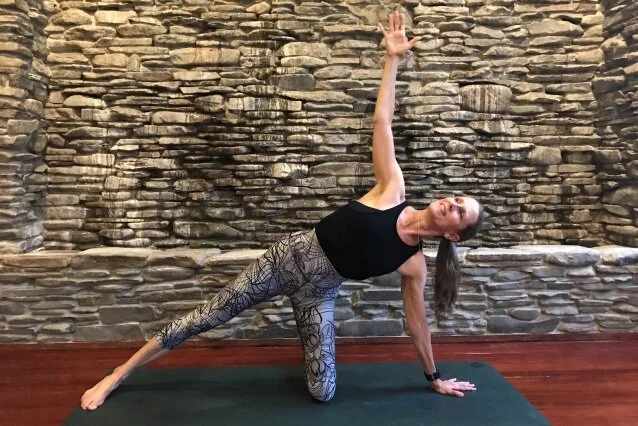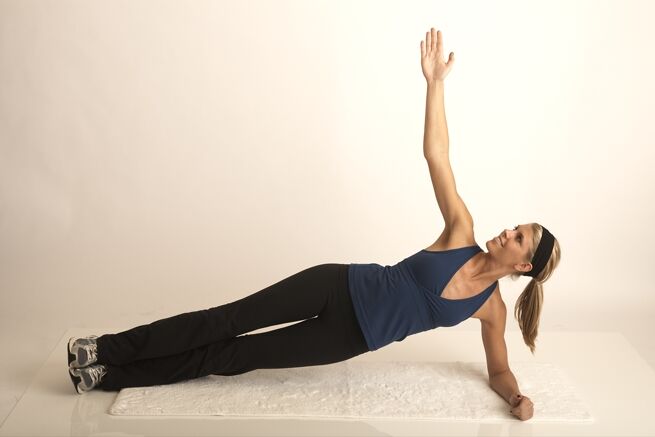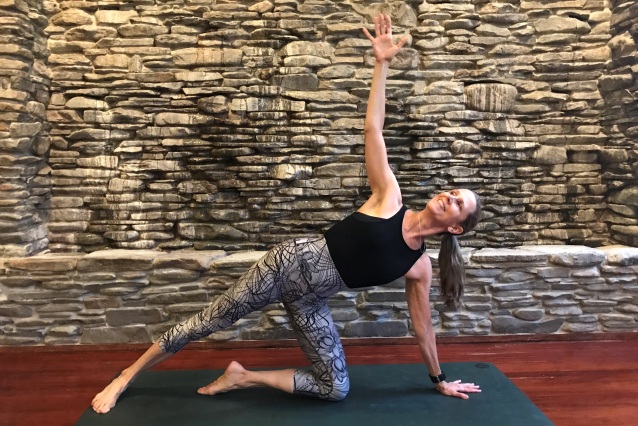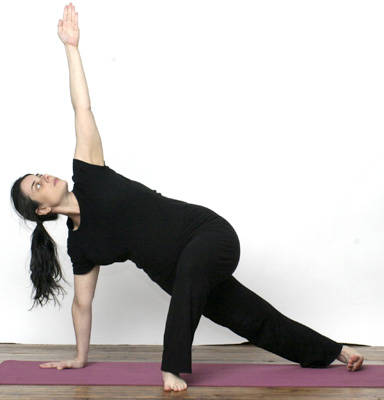A good, strong Side Plank is the basis forVisvamitrasana. As such, I’d like topoint out some helpful and some not so helpful variations for this lateral armbalance.
Side Plank is a great pose for core strength and balance,but it can be a difficult pose for beginners or for people with shoulderissues. There are several modificationsfor this pose: for the arms and shouldersand for the legs.
Let’s look at the shoulder modifications first.
You can do Side Plank on your hand, or on your forearm. If you do Side Plank on your forearm, makesure that you turn your forearm to be in line with your body, not crossed infront of you and perpendicular to your body. First of all, Vasisthasana isprimarily a balance pose, by turning the forearm in, you lose the challenge toyour balance. Also, turning the forearmin rotates the head of the arm bone in and creates stress and impingement onthe shoulder joint. The head of the armbone should be in neutral alignment in the shoulder socket.
Don't turn your forearm in this way. I will replace this picture with one that shows the correct placement of the forearm
I have worked with some students who have shoulder injuries,or who have just come back from shoulder surgery and should not be attempting aweight bearing pose, yet. For thosestudents, I have them work in a standing version of Vasisthasana with theirhand on the wall. This buildsflexibility, strength and awareness to prepare you for moving to the floor.
Leg modifications.
One of the most basic beginner leg modifications is to bend the bottom leg. I find this version of Side Plank more challenging than being on the edge of one foot.
This is a shoulder friendly pose and it helps develop core strength
Recognizing this, a lot of teachers instruct their newer students to plant their bottom knee and rotate the shin 90 degrees behind them. I do not recommend this for two reasons: One: is that you quite possibly set up a scenario for impingement in the hip*(I’ll describe this below) and, Two: is that by triangulating the bottom foot out, you remove all possibility to work on balance in the pose. In order for this version to work as a balance pose, the bottom hand, the knee, shin and top leg need to be all on a “Balance Beam”. Imagine an 8 inch wide stripe down the middle of your mat and line everything up on that. If you cannot balance that way, then let the bent leg foot turn out an inch or two, but not more. This is meant to challenge your core to hold you in alignment and in balance!
This shows the bottom leg turned out 90 degrees. I don't recommend this variation.
Here is the same pose seen from behind.
I usually prefer the version with the top leg bent. This version takes a lot of weight off of thestanding arm and shoulder. It is moresimilar to the full pose in that you can press down and lift your hips. It does still make a triangulation, but notwith risk to compression in the hip joint. And it sets you up for stacking the top leg onto the bottom leg for thefull pose when you are ready.
I prefer this modification for Side Plank
Compression in the hip joint with the bottom leg bent andturned out.
To understand this, you need to know some basicanatomy. Let’s take a look at a femurbone. At the top of the femur bone is around ball, known as the head of the femur. Off to the side is a large piece of bone that protrudes up and out. This is called the greater trochanter. The head of the femur bone fits into a socketon the side of the pelvis and when we bend at the hips, the pelvis is moving inrelationship to the femur bone.
Notice the greater trochanter and the side of the pelvis above it.
When we do Triangle Pose, the first thing we do once thelegs are spread wide apart is to turn the front leg out 90 from the hip. There is a biomechanical reason forthis. If we simply stood with the legsspread wide and the toes pointing straight ahead and tried to lean our torsoover the right leg, the side of our pelvis would tip over and bump into the tipof the greater trochanter. You wouldn’tget very far before that stopped you. Youmight not feel anything except some sort obstruction in the way, but a lot ofpeople might feel pain from compression of tissues in the joint.
Here you can see the side of the pelvis bumping up against the greater trochanter.
When you turn the leg out 90 degrees as we do for Triangle,you are turning the greater trochanter out of the way. Now the pelvis can tip more freely over theleg bone to bring you into Triangle. Thesame pattern happens in Side Plank. Ifyou triangulate the bottom leg outward, when you go to lean over, the pelvis istipping onto the greater trochanter. Itis better: more comfortable, greater range of motion and less chance ofimpingement, when you keep the bottom shin in line with the hand and foot thatare on the floor.
Here I have externally rotated the femur bone, moving the greater trochanter out of the way.









